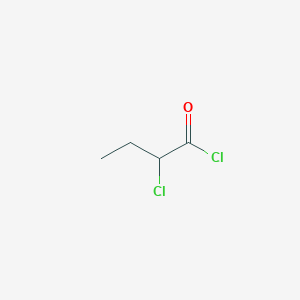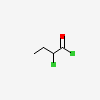2-Chlorobutyryl chloride
- 2-CHLOROBUTYRYL CHLORIDE
- 7623-11-2
- 2-chlorobutanoyl chloride
- Butanoyl chloride, 2-chloro-
- 2-CHLOROBUTYRYLCHLORIDE
- Create:2005-03-27
- Modify:2024-12-28

- 2-CHLOROBUTYRYL CHLORIDE
- 7623-11-2
- 2-chlorobutanoyl chloride
- Butanoyl chloride, 2-chloro-
- 2-CHLOROBUTYRYLCHLORIDE
- 2-chloro-butyryl chloride
- chlorobutyric chloride
- alpha-chlorobutyroylchloride
- alpha-chlorobutyryl chloride
- alpha-chlorobutanoyl chloride
- SCHEMBL501721
- DTXSID10997573
- STL453678
- 2-Chlorobutyryl chloride, tech. 85%
- AKOS005206913
- AS-88647

P260, P264, P280, P301+P330+P331, P302+P361+P354, P304+P340, P305+P354+P338, P316, P321, P363, P405, and P501
(The corresponding statement to each P-code can be found at the GHS Classification page.)
Aggregated GHS information provided per 4 reports by companies from 1 notifications to the ECHA C&L Inventory.
Information may vary between notifications depending on impurities, additives, and other factors. The percentage value in parenthesis indicates the notified classification ratio from companies that provide hazard codes. Only hazard codes with percentage values above 10% are shown.
Patents are available for this chemical structure:
https://patentscope.wipo.int/search/en/result.jsf?inchikey=KVQJVAOMYWTLEO-UHFFFAOYSA-N
- ChemIDplusButanoyl chloride, 2-chloro-https://pubchem.ncbi.nlm.nih.gov/substance/?source=chemidplus&sourceid=0007623112ChemIDplus Chemical Information Classificationhttps://pubchem.ncbi.nlm.nih.gov/source/ChemIDplus
- EPA DSSTox2-Chlorobutanoyl chloridehttps://comptox.epa.gov/dashboard/DTXSID10997573
- European Chemicals Agency (ECHA)LICENSEUse of the information, documents and data from the ECHA website is subject to the terms and conditions of this Legal Notice, and subject to other binding limitations provided for under applicable law, the information, documents and data made available on the ECHA website may be reproduced, distributed and/or used, totally or in part, for non-commercial purposes provided that ECHA is acknowledged as the source: "Source: European Chemicals Agency, http://echa.europa.eu/". Such acknowledgement must be included in each copy of the material. ECHA permits and encourages organisations and individuals to create links to the ECHA website under the following cumulative conditions: Links can only be made to webpages that provide a link to the Legal Notice page.https://echa.europa.eu/web/guest/legal-notice[No public or meaningful name is available]https://echa.europa.eu/substance-information/-/substanceinfo/100.204.191
- Japan Chemical Substance Dictionary (Nikkaji)
- NIST Mass Spectrometry Data CenterLICENSEData covered by the Standard Reference Data Act of 1968 as amended.https://www.nist.gov/srd/public-lawButanoyl chloride, 2-chloro-http://www.nist.gov/srd/nist1a.cfm
- Springer Nature
- Thieme ChemistryLICENSEThe Thieme Chemistry contribution within PubChem is provided under a CC-BY-NC-ND 4.0 license, unless otherwise stated.https://creativecommons.org/licenses/by-nc-nd/4.0/
- Wikidata2-Chlorobutanoyl chloridehttps://www.wikidata.org/wiki/Q82989753
- Wiley
- PubChem
- GHS Classification (UNECE)GHS Classification Treehttp://www.unece.org/trans/danger/publi/ghs/ghs_welcome_e.html
- MolGenieMolGenie Organic Chemistry Ontologyhttps://github.com/MolGenie/ontology/
- PATENTSCOPE (WIPO)SID 403408081https://pubchem.ncbi.nlm.nih.gov/substance/403408081

